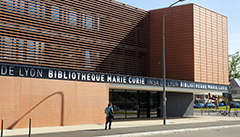
Sciences & Société
Soutenance de thèse : Alexandru TECHERES
23/10/2024 à 21h (CEST) / 24/10/2024 à 6h (AEDT)
Doctorant : Alexandru TECHERES
Laboratoire INSA : MATEIS
Ecole doctorale : ED34 : Matériaux de Lyon
The strengthening of Al alloys via Sc and Zr has been well documented in the literature. The formation of L12 Al3Sc and Al3Zr leads to improvements of mechanical properties through formation of precipitates during artificial ageing. However, the scarcity and cost of Sc have always been a challenge towards adoption on an industrial scale. Nonetheless, new mineral deposits discovered in Australia, together with novel processing methods create the expectation that the price of Sc will become more accessible.
In the context of a circular economy, recycling is the norm. However, this introduces impurities in the recycled material which originate from the imperfect sorting of scraps. The precipitation kinetics of Al3Sc in high purity, controlled composition Al alloys is well understood. However, the precipitation process in the presence of impurities such as Fe and Si has not been studied.
Therefore, the problematic of the current thesis focuses of the effect of impurities on the precipitation kinetics in Al-Sc-Zr during artificial ageing at various temperatures. Previous reports in the literature indicate an accelerating effect of Si and there are limited reports on the effect of Fe.
Using a combinatorial method, in this work we investigate the effect of Si on the precipitation kinetics via samples with a macroscopic composition gradient (also called diffusion couples). Additionally, two sets of samples are investigated with different Fe concentration to comparatively study the effect of Fe. The precipitation kinetics is observed indirectly via small angle x-ray scattering (SAXS) and hardness measurements across the samples with macroscopic composition gradient. Furthermore, advanced characterisation techniques such as Scanning Electron Microscopy, Transmission Electron Microscopy and Atom Probe Tomography are employed to analyse conditions determined as critical during the ageing.
A strong acceleration effect was observed, with increased Si, agreeing with previous reports. However, a saturation effect was identified, which seems to depend on the ageing temperature. This is discussed as a function of Si-vacancy interaction in the precipitation of Al3Sc. Modelling in a Kampmann-Wagner Numerical framework was performed assuming various numbers of heterogenous nucleation sites. To match experimental results, it was required to increase the diffusion coefficient of Sc in the presence of Si, further highlighting the acceleration effect.
It was identified via TEM and APT that the presence of Si leads to smaller mean radius and larger volume fraction of precipitates, which promote larger increments of the mechanical properties. Furthermore, it was observed that Si replaces Al in the structure of the precipitates and that the concentration of Si in the precipitates increases with the concentration in the solid solution.
Finally, it was observed that Fe can replace Al in the precipitates too. Moreover, in the presence of Fe, Si is found in higher concentrations inside the precipitate than when Fe is virtually absent. However, only a minimal difference is observed in terms of hardening between the alloys with different Fe content and only early in the ageing process. Analytical strengthening calculations seem to predict well the hardening in a Fe-free alloy but poorly in the Fe-rich one. This indirectly suggests that Fe has an effect on the precipitation kinetics, but more investigations are needed to fully understand the effect of Fe on precipitation in these alloys.
Información adicional
-
https://deakin.zoom.us/j/83683315974?pwd=v9dIuNeebiCxC8etah5ItcjBK5q6Ue.1 (Waurn Ponds, Australia)
Últimos eventos
19ᵉ Colloque S.mart "Recherche et enseignement agiles pour une industrie soutenable"
Desde 12 Hasta 15 MayoAteliers danse avec la Cie MF
Les 15 et 22 mai 2025
Sciences & Société
Soutenance de thèse : Emna MASGHOUNI
Eco-design and processing of polymer composites towards the shielding of EMI by absorption: Processing, structure, and properties relationship
Doctorante : Emna MASGHOUNI
Laboratoire INSA : IMP
École doctorale : ED34 : Matériaux de Lyon
Información adicional
-
Amphithéâtre Clémence Augustine Royer, Bâtiment Jacqueline Ferrand, INSA-Lyon (Villeurbanne)
Últimos eventos
19ᵉ Colloque S.mart "Recherche et enseignement agiles pour une industrie soutenable"
Desde 12 Hasta 15 MayoAteliers danse avec la Cie MF
Les 15 et 22 mai 2025
Sciences & Société
Soutenance de thèse : Louis LESAGE
Thermodynamic and kinetic control of liquid metal dealloying for the design of porous metallic powders
Doctorant : Louis LESAGE
Laboratoire INSA : MATEIS
Ecole doctorale : ED34 Matériaux de Lyon
Metallic powders are becoming increasingly widespread due to their use in additive manufacturing processes and as catalytic materials. In this context, it is appealing to develop processes that enable the formation of open porosities in metallic powders to modify their mechanical properties and increase their specific surface area. We propose using liquid metal dealloying (LMD) to create porous powders with modified microstructures and properties. LMD is a novel technique that involves the selective dissolution of an alloying element from a precursor in a liquid metal solvent. This results in the formation of a continuous ligament structure and open porosity in the dealloyed layer.
By mixing precursor and solvent powders and heating them above the melting temperature of the solvent, we successfully dealloyed FeNi and NiCu precursor powders. This process led to either fully porous or partially porous microstructures featuring core- shell morphologies. To better understand the kinetics of the dealloying process and the resulting microstructure, we developed a diffusion model based on thermodynamic principles and successfully compared it with experimental results obtained from NiCu alloys immersed in liquid Ag. Additionally, we used in situ X-ray diffraction to monitor the phase transformations occurring during the dealloying of FeNi particles by Mg. This combination of experimental and simulation work demonstrates how dealloyed structures are controlled by equilibrium thermodynamics and/or the kinetics of the dealloying reaction. Our results highlight the potential of LMD to design dealloyed powders with tailored dealloyed fractions, ligament sizes, compositions, and microstructures. Finally, we propose using compression tests applied to powders to assess their suitability for applications in cold spray.
Información adicional
-
Amphithéâtre de BU, Lyon 1 (Villeurbanne)
Últimos eventos
19ᵉ Colloque S.mart "Recherche et enseignement agiles pour une industrie soutenable"
Desde 12 Hasta 15 MayoAteliers danse avec la Cie MF
Les 15 et 22 mai 2025
Sciences & Société
Soutenance de thèse : Nicolas Madinier
Caractérisation vibratoire de structures par méthodes inverses et mesures plein champ
Doctorant : Nicolas Madinier
Laboratoire INSA : LVA
École doctorale : ED162 : MEGA de Lyon (Mécanique, Énergétique, Génie civil, Acoustique)
Le développement de nouveaux matériaux alliant résistance mécanique et légèreté est un enjeu d'actualité dans de nombreux secteurs industriels. Afin de pouvoir utiliser ces matériaux, il est nécessaire de connaître leurs propriétés mécaniques. Pour les déterminer, des méthodes inverses analysant le comportement vibratoire de la structure peuvent être utilisées. Dans ce travail de thèse, deux méthodes sont utilisées : la Résolution Inverse (RI) et la Méthode des Champs Virtuels (MCV).
Dans un premier temps, les méthodes sont appliquées avec la déflectométrie optique, une méthode de mesure plein champ. L'utilisation de cette méthode de mesure avec les deux méthodes inverses permet d'obtenir des cartographies précises de la rigidité de flexion et de l'amortissement de la structure étudiée. La déflectométrie optique mesure les pentes du champ de déplacement. Une opération de gradient inverse permet de remonter au champ de déplacement. Afin de supprimer cette opération, le développement de formalismes sur les pentes de RI et de la MCV est proposé. Ces formalismes sont testés avec des simulations numériques puis une étude expérimentale est présentée.
Dans un second temps, une variante de la MCV est développée. Cette variante a pour but d'appliquer la méthode en hautes fréquences où RI et la MCV ne sont plus applicables. La Résolution Inverse Corrigée est une variante de RI qui a pour but d’appliquer la méthode dans les hautes fréquences.
La variante de la MCV qualifiée de Méthode des Champs Virtuels Adaptée en Fréquence consiste à déterminer à chaque fréquence la taille de l’intervalle d’intégration des intégrales du Principe des Travaux Virtuels (une forme faible de l'équilibre local sur laquelle se base la MCV). Elle est développée pour la poutre d'Euler-Bernoulli et la plaque de Love-Kirchhoff et est testée sur des données expérimentales pour identifier la rigidité de flexion complexe d'une plaque amortie localement.
Información adicional
-
Amphithéâtre ouest des Humanités, INSA-Lyon (Villeurbanne)
Últimos eventos
19ᵉ Colloque S.mart "Recherche et enseignement agiles pour une industrie soutenable"
Desde 12 Hasta 15 MayoAteliers danse avec la Cie MF
Les 15 et 22 mai 2025
Sciences & Société
Soutenance de thèse : Hugo GIRARD
Characterization of the fiber-matrix interface fracture properties in long fiber composites
Doctorant : Hugo GIRARD
Laboratoire INSA : MATEIS
École doctorale : ED34 : Matériaux de Lyon
Fiber-matrix interface in long fiber composite is a key aspect of global composite mechanical properties since it drives damage initiation and load transfer. Fiber-matrix interface debonding is usually the first type of damage that occurs when the composite is subjected to transverse loading. After initiation, the interface debonding propagates and often kinks into the matrix, leading to further critical defects for the structure. As a result, it is crucial to accurately characterize the fiber-matrix interface in order to prevent or control damage in composites. Going beyond existing experimental methods currently focused on interface shear fracture properties, single-fiber microcomposite tensile sample loaded transversely are developed to simultaneously characterize opening and shear fracture properties. An accurate experimental characterization of the fiber-matrix debonding process allowed the identification of the interface fracture properties using adequate 2D and 3D numerical approaches and related fracture models such as the Coupled Criterion (CC) and Cohesive Zone Models (CZM). Both the CC and the CZM are able to reproduce the experimentally observed debonding process in 2D, the 3D model being able to describe the free surface singularity. In 3D, the fracture property identification yields tensile strengths and critical energy release rates respectively slightly higher and in the same order of magnitude than those identified in 2D. The 3D model does not enable identifying the shear fracture properties, unlike in 2D. In 2D the optimal initiation crack shapes correspond to i) the stress isocontours for small brittleness numbers, ii) the energy-based shapes for large brittleness numbers and iii) neither of them for intermediate brittleness numbers. The 2D stress isocontours-based debonding shapes provide an accurate estimate of the initiation loading. In 3D, the optimum initiation crack always corresponds to energy-based debonding shapes and the 3D stress isocontours-based debonding shapes may thus overestimate the initiation loading by up to 30%.
Información adicional
-
Amphithéâtre Gaston Berger, INSA-Lyon (Villeurbanne)
Últimos eventos
19ᵉ Colloque S.mart "Recherche et enseignement agiles pour une industrie soutenable"
Desde 12 Hasta 15 MayoAteliers danse avec la Cie MF
Les 15 et 22 mai 2025
Sciences & Société
Soutenance de thèse : Junxiong WANG
Molecular dynamics simulation of semicrystalline polymers: from molecular topology to mechanical properties
Doctorant : Junxiong WANG
Laboratoire INSA : MateiS
École doctorale : ED34 : Matériaux de Lyon
Semi-crystalline polymers have attracted widespread attention due to their wide range of industrial applications, attractive mechanical properties, and good chemical resistance. Semi-crystalline polymers exhibit excellent mechanical properties due to their unique molecular structure (crystalline and amorphous phases overlapping each other). Topological molecules, like ties, loops, … and entanglements in amorphous phase, serve as stress transmitters and can be crucial to mechanical properties. However, these microstructures cannot be studied quantitatively experimentally, and the nonequilibrium process of crystallization and how the microstructure affects mechanical properties cannot be studied at the nanoscale. The dependence of the mechanical properties of semi-crystalline polymers on topology and entanglement has been explored using a coarse-grained model through molecular dynamics simulations. From cooling a melt, and after isothermal treatment, semi-crystalline polymers with lamellar structures were obtained with different entanglement densities and topologies. The strongest mechanical properties are shown when the tensile direction is highly consistent with the crystal chain orientation. And the system with a higher entanglement density has a smaller yield stress but a significant stress-hardening regime, indicating that high entanglement density effectively increases the stress-hardening effect. Additionally, the effect of different topologies on mechanical properties has been explored. Uniaxial tensile test results show that cilia have little effect on mechanical properties. The yield stress increases with the number of loops, showing that not only the loops but also the number of topologies has a strong influence on the mechanical properties. The tie molecules appear to have a slightly greater impact on the mechanical properties than the loops, manifesting in a slight strain softening effect. These results will enhance the understanding of the relationship between microstructure and mechanical properties of semicrystalline polymers.
Información adicional
-
Amphithéâtre Emilie du Châtelet (Bibliothèque Marie Curie) - Villeurbanne
Últimos eventos
19ᵉ Colloque S.mart "Recherche et enseignement agiles pour une industrie soutenable"
Desde 12 Hasta 15 MayoAteliers danse avec la Cie MF
Les 15 et 22 mai 2025
Sciences & Société
Soutenance de thèse : Yiping CHEN
New Approaches for the Construction of Ternary Solute/Solvent/Non-solvent Phase Diagrams and Applications in the Field of Nanoprecipitation
Doctorante : Yiping CHEN
Laboratoire INSA : IMP
École doctorale : ED34 : Matériaux de Lyon
Nanoprecipitation (or solvent-displacement, Ouzo effect) process is a promising technique for straightforwardly producing colloids of controlled dimensions without recourse to surfactants or any high shearing force systems. Successful applications of the nanoprecipitation process crucially rely on the ability to construct the phase diagrams for the solute/solvent/nonsolvent ternary system of interest by identifying regions (SFME, Ouzo domain…) where the hydrophobic solute aggregates at the nanometer scale. Therefore, the main aim of this thesis is to develop robust methods to construct phase diagrams, to attempt at enlarging the Ouzo domain through cautiously-chosen additives, and finally to use thus constructed phase diagrams for precipitation of novel molecules, targeting potential applications in the biological field.
Combined fluorescence microscopy (FM) and dynamic light scattering (DLS) techniques were first used to construct phase diagrams containing pyrene as fluorescent indicator and surfactants as stabilizers in oil/solvent/water systems, respectively. It has been found that under the micrometer resolution FM, the pyrene-loaded nanodispersions appear black in the Ouzo domain (owing to their nanoscale dimensions). In DLS tests, adding a non-ionic surfactant, the Ouzo domain showed a monodisperse peak, with dI > dN and PDI < 0.15. Remarkably, the Ouzo domain identified by DLS was slightly larger than that obtained by FM owing to the introduction of surfactants. In a second approach, using the DLS technique, we studied the effect of adding specific surfactants (Brij 56, Enordet J3131, Cremophor EL) on the nanoprecipitation process. With miglyol oil, the Ouzo limit was shifted up to two decades, significantly enhancing the Ouzo domain. Finally, solid molecules such as antibiotics and fluorophores were used as solutes for nanoprecipitation. One specific antibiotic showed similar efficacy against various bacteria in molecular state or under nanoparticle form in vitro testing. Nanodispersions of high Tg fluorophores keep a good colloidal stability over a long period, and maintain their fluorescence activity upon dilution, making them good candidates as biomarkers.
Información adicional
-
Amphithéâtre CNRS Rhône-Auvergne (Villeurbanne)
Últimos eventos
19ᵉ Colloque S.mart "Recherche et enseignement agiles pour une industrie soutenable"
Desde 12 Hasta 15 MayoAteliers danse avec la Cie MF
Les 15 et 22 mai 2025
Sciences & Société
Soutenance de thèse : Yohan DOUEST
Development of Ti-based bulk metallic glasses for dental applications through innovative design strategy, process optimisation and surface functionalisation
Doctorant : Yohan DOUEST
Laboratoire INSA : MATEIS
École doctorale : ED34 : Matériaux de Lyon
Due to their long-range disordered atomic structure, Ti-based bulk metallic glasses (BMGs) exhibit at least twice the mechanical strength of crystalline Ti-alloys currently used in dental implant applications. Ti-based BMGs are therefore candidate materials to downsize dental implant components and reduce their invasiveness. Although numerous research works have emphasised their potential, no commercial products have been made available. Several aspects hinder their practical application. Firstly, they generally contain high amount of copper. Apart the controversy regarding its biological safety, copper has been shown to trigger pitting corrosion in chloride environment of amorphous alloys, thereby limiting their corrosion resistance. Secondly, Ti-based BMGs are challenging to process. Because of their restricted glass forming ability (GFA), they are more prone to the formation of crystalline heterogeneities even when high cooling rates are applied.
This PhD investigates independent research areas related to Ti-based BMGs, ranging from designing strategies and processability to surface functionalisation. At first, a machine learning (ML) model is employed to explore compositional spaces with reduced amount of copper within the Ti-Zr-Cu-Pd system. The model’s predictions are experimentally assessed, and a critical discussion is provided on the relevance of the ML-guided approach. Secondly, the processability of Ti40Zr10Cu36Pd14, a representative composition of Ti-based BMGs, is evaluated. Processing techniques from both laboratory and industry are compared, and the resulting as-cast crystalline heterogeneities are studied to give insights into their formation pathways. Lastly, two surface modifications aimed at reducing the influence of copper on the corrosion resistance of Ti40Zr10Cu36Pd14 are proposed. One solution involves the deposition of coating already used in dental implant systems while the second solution consists of a chemical etching treatment. The results obtained within this PhD aim to contribute both scientific and industrial advancements, while also suggesting new research topics.
Información adicional
-
Salle des thèses, Bâtiment Irène Joliot Curie (bât. INL), INSA-Lyon (Villeurbanne)
Últimos eventos
19ᵉ Colloque S.mart "Recherche et enseignement agiles pour une industrie soutenable"
Desde 12 Hasta 15 MayoAteliers danse avec la Cie MF
Les 15 et 22 mai 2025
Sciences & Société
Soutenance de thèse : Raouhi SANAA
Valorisation de la réaction thia-Michael pour la synthèse d’architectures macromoléculaires à base d’isosorbide
Doctorant : Raouhi SANAA
Laboratoire INSA : IMP (Ingénierie des Matériaux Polymères)
École doctorale : ED34 : Matériaux de Lyon
Ces travaux de thèse explorent la synthèse et la caractérisation de nouveaux copolymères poly(thioéther-ester) contenant des unités monomères dérivés de 1,4:3,6- dianhydrohexitols (isosorbide et isomannide) via la réaction thia-Michael. Les efforts se concentrent sur la génération de diverses architectures macromoléculaires linéaires, réticulées ou hybrides organique/inorganique avec des blocs poly(diméthylsiloxane). Dans un premier temps, une revue de littérature met en évidence l'intérêt des stéréoisomères 1,4:3,6-dianhydrohexitols comme monomères de base pour la synthèse de polymères, tout en examinant les mécanismes et les conditions optimales de la réaction thia-Michael ionique. Dans un deuxième temps, la synthèse détaillée de copolymères poly(thioéther-ester) en utilisant différents monomères dont certains au moins sont dérivés d’isosorbide ou d’isomannide, comme des dithiols et diacrylates, ou diméthacrylates, est abordée. Les conditions opératoires et les caractéristiques des produits obtenus, tels que des polymères linéaires de haute masse molaire, des polymères à masse molaire et bouts de chaînes contrôlés et des réseaux réticulés chimiquement, sont discutés. Ensuite, les possibilités de modification chimique des poly(thioéther-ester)s par oxydation sélective ou aléatoire des groupes thioéther en sulfoxyde et/ou sulfone, ainsi que leur impact sur les propriétés physico-chimiques des copolymères, sont explorées. Enfin, l'introduction de segments flexibles de poly(diméthylsiloxane) dans les copolymères, conjointement avec l'incorporation d'unités isosorbide, est étudiée. Les propriétés thermiques des nouveaux matériaux sont analysées en détail.
Información adicional
-
Amphithéâtre de la délégation du CNRS Rhône Auvergne (Villeurbanne)
Últimos eventos
19ᵉ Colloque S.mart "Recherche et enseignement agiles pour une industrie soutenable"
Desde 12 Hasta 15 MayoAteliers danse avec la Cie MF
Les 15 et 22 mai 2025
Sciences & Société
Soutenance de thèse : Yufei WANG
Layer by layer polymer films involving functionalized-PPFS building blocks: from chemical design control to film features
Doctorante : Yufei WANG
Laboratoire INSA : IMP (Ingénierie des Matériaux Polymères)
École doctorale : ED34 : Matériaux de Lyon
Ce travail de thèse à vocation fondamentale décrit la synthèse de nouveaux dérivés de poly (2, 3, 4, 5, 6- pentafluoro-styrene) (PPFS) et de PPFS-co-PS modifiés chimiquement, présentant un caractère de donneur ou accepteur de liaisons hydrogène, et leur utilisation comme briques de base élémentaires pour concevoir des films LbL multicouches aux propriétés ajustables. La fonctionnalisation chimique a été réalisée par une réaction de substitution nucléophile chimiosélective et régiosélective en position para du cycle fluoré des unités PFS, en utilisant différents thiols polaires comme agents nucléophiles. Ainsi, des dérivés mercapto composés de groupements amine (amine primaire: cystéamine et amine tertiaire: diméthylaminoéthanethiol), et de groupements acide carboxylique (acide mercapto propionique) ont été greffés avec succès sur les chaînes polymère, et les paramètres expérimentaux (temps de réaction, quantité de base ajoutée) ont été optimisés et modifiés, afin de générer un large éventail de dérivés différant de par leur degré de substitution et/ou leur fonctionnalité, facteurs qui permettent d’ajuster notamment leur capacité à interagir. Leur aptitude à interagir a été tout d’abord examinée au sein de mélanges en solution et il est apparu qu’en fonction de la nature du solvant et de la structure des espèces introduites le long des chaines, différents scénaris ont été obtenus : mélanges immiscibles, mélanges miscibles et complexes interpolymères, liés notamment au caractère transparent ou turbide de la solution. L’observation macroscopique des mélanges a été complétée par une étude à l’état solide, après évaporation du solvant et cette analyse a mis en évidence la formation d’interactions entre les dérivés de PFFS modifiés, impliquant principalement des liaisons hydrogène entre les espèces aminées et carboxylées. Au final, les combinaisons les plus appropriées de polymères modifiés ont été utilisés pour construire avec succès des films LbL multicouches, par un procédé de dépôt par immersion. L’influence de différents paramètres liés aux aspects structuraux des polymères (degré de modification, structure du thiol greffé), et liés au procédé de dépôt (concentration des polymères, nature du solvant) a été étudiée de façon approfondie. Il en résulte que tous ces paramètres influencent étroitement, le mécanisme de croissance, l’épaisseur, l’organisation interne, les propriétés de mouillabilité, et la morphologie de surface des films LbL finaux.
Información adicional
-
Amphithéâtre de la délégation du CNRS Rhône Auvergne (Villeurbanne)

